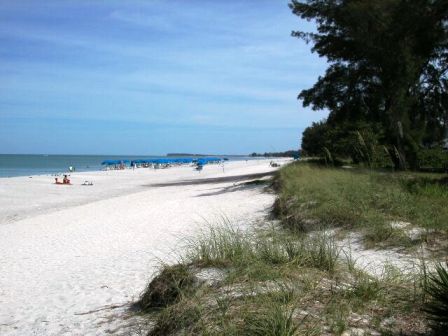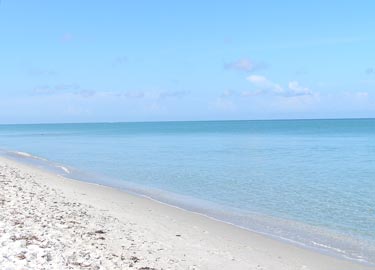Discover Florida Nature
It's time to explore the natural Florida


|
|
|
|
|
 You
will be captivated by beautiful, alluring Captiva Island, where once, it
is said, pirates roamed, conquistadors explored and
Calusa Indians called home. The mystery and adventure is
still here. Treasures to be found in the way of a good life, spectacular
white sand beaches scattered with "treasures from the sea", pastel
colored seashells and breathtaking sunrises and sunsets. Captiva Island
is an island in Lee County in southwest Florida, located just offshore
in the
Gulf of Mexico. Originally part of
neighboring Sanibel Island to the southeast, it was severed when a
hurricane's storm surge washed away a new channel, called Blind Pass,
which has now been filled in with sand. You
will be captivated by beautiful, alluring Captiva Island, where once, it
is said, pirates roamed, conquistadors explored and
Calusa Indians called home. The mystery and adventure is
still here. Treasures to be found in the way of a good life, spectacular
white sand beaches scattered with "treasures from the sea", pastel
colored seashells and breathtaking sunrises and sunsets. Captiva Island
is an island in Lee County in southwest Florida, located just offshore
in the
Gulf of Mexico. Originally part of
neighboring Sanibel Island to the southeast, it was severed when a
hurricane's storm surge washed away a new channel, called Blind Pass,
which has now been filled in with sand. Captiva Island, sister to larger Sanibel Island, is just over a small bridge which crosses at Turner Beach. Turner Beach is a great place for catching that prize fish and also for finding the colorful shells that these islands are famous for. The beach stretches 5 miles to the northern tip of Captiva Island at Redfish Pass. From the bridge at Turner beach, Captiva Drive is a scenic drive past giant cactus, colorful bougainvilleas and other tropical flora along a stretch of sea and sand ending at "downtown" Captiva, which is more of a village than a town. Sanibel and Captiva formed as one island about 6000 years ago. Captiva has been home to the Calusa Indians, a boarding school for boys and a large key lime plantation. The quaint Chapel by the Sea exudes old-island charm. Captiva was also the favorite hangout of the late, great, forward-thinking political cartoonist J.N. "Ding" Darling. Other notables who sought escape on the islands before the causeway made visits easier and more popular include Teddy Roosevelt, Charles and Anne Morrow Lindbergh and Edna St. Vincent Millay. From artist Robert Rauschenberg to weatherman Willard Scott, the famous still seek refuge at this preserve for wildlife and the human soul. Captiva was seriously damaged in August 2004 when the eastern eyewall of Hurricane Charley struck North Captiva, immediately before hitting Charlotte Harbor to the north-northeast.  Captiva
Island is all about the outdoors. Bike, sail or cruise the island for
incredible views of the Gulf of Mexico. Sanibel and Captiva Islands has
large variety of Florida Wildlife including birds,
alligators and
dolphins. Snowy egrets and great egrets are
among the more active feeders, flying over the pools to snatch fish
while in flight. Tri-colored herons and reddish egrets also hunt busily,
running in shallow areas in pursuit of food.
White ibis walk along the edge of the water, their long, de-curved
bills probing for small crustaceans, a bird watchers dream come true. Captiva
Island is all about the outdoors. Bike, sail or cruise the island for
incredible views of the Gulf of Mexico. Sanibel and Captiva Islands has
large variety of Florida Wildlife including birds,
alligators and
dolphins. Snowy egrets and great egrets are
among the more active feeders, flying over the pools to snatch fish
while in flight. Tri-colored herons and reddish egrets also hunt busily,
running in shallow areas in pursuit of food.
White ibis walk along the edge of the water, their long, de-curved
bills probing for small crustaceans, a bird watchers dream come true.
Captiva Island is home to blue skies, warm waters, scenic palm trees and white sand beaches. Upper Captiva Island is approximately four and a half miles long and a half a mile wide at its widest points. From the mangrove lined waters of the Bay to the sandy beaches of the Gulf of Mexico, half a mile seems just right. Sanibel and Captiva Islands area offers prime fishing for many species including the much sought after snook, redfish, sea trout and tarpon. The annual migration of tarpon starts around mid-April and goes well into the month of July. Beyond North Captiva lies Cayo Costa, a mostly-deserted island with a few homes, and a state park and campground. Many Calusa artifacts have been discovered on the beautiful beaches of Cayo Costa. There are no businesses or rental accommodations here beyond the state campground. Nearby is popular Cabbage Key. Suspected of being the inspiration for Jimmy Buffett's song "Cheeseburger in Paradise" this funky island has a restaurant and bar, overnight accommodations, a large marina, and lots of ducks. It's also the highest point in the county. |
|
|
Captiva Island Florida
Captiva Island Florida is where pirates roamed, conquistadors explored and Calusa Indians called home. Floridian nature is bountiful with birds, alligators and dolphins all calling Captiva Island home. Snowy egrets and great egrets are among the more active feeders, flying over the pools to snatch fish while in flight. Tri-colored herons and reddish egrets are also plentiful.
Captiva Island is home to blue skies, warm waters, scenic palm trees and white sand beaches. Upper Captiva Island is approximately four and a half miles long and a half a mile wide at its widest points. From the mangrove lined waters of the Bay to the sandy beaches of the Gulf of Mexico, half a mile seems just right.
Captiva Island offers prime fishing for many species including the much sought after snook, redfish, sea trout and tarpon. The annual migration of tarpon starts around mid-April and goes well into the month of July.Birding, hiking and basking in the Florida sun all are options for spending your day. Captiva Island is truly Floridian nature at its best!
Written by: Floridian Nature
Captiva Island
Date published: 10/22/2013
4 / 5 stars
|
|